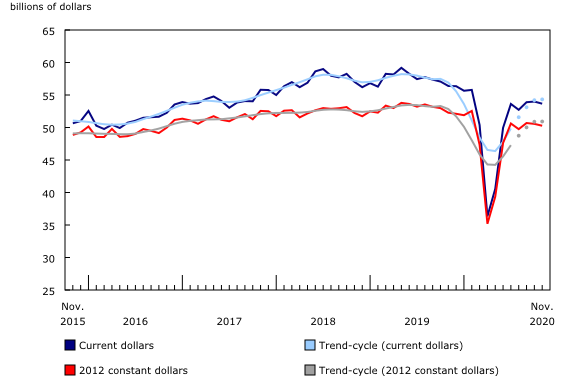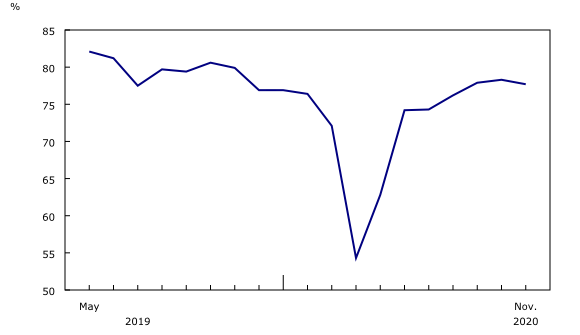Monthly Survey of Manufacturing, November 2020
Archived Content
Information identified as archived is provided for reference, research or recordkeeping purposes. It is not subject to the Government of Canada Web Standards and has not been altered or updated since it was archived. Please "contact us" to request a format other than those available.
Released: 2021-01-19
Manufacturing sales decreased for the first time in three months, declining 0.6% to $53.7 billion in November. Sales were down in 5 of 21 industries, driven mainly by the aerospace product and parts, motor vehicle, and motor vehicle parts industries.
Manufacturing sales in constant dollars decreased 0.6%, indicating that a lower volume of goods was sold in November.
Transportation equipment drives the decline
Sales in the transportation equipment industry decreased 9.1% to $8.9 billion in November, following a 0.8% decline in October. Sales rose in the motor vehicle body and trailer industry (+5.9%) and declined in all of the other transportation equipment industries.
Aerospace production fell 23.8% to $1.2 billion in November, following a 5.5% decrease in October. Travel restrictions and market uncertainty attributable to the COVID-19 pandemic continued to negatively affect aerospace production in November. On a year-over-year basis, production was down 45.5%.
Following a 1.7% increase in October, motor vehicle sales decreased 5.7% to $4.3 billion in November. Sales were 10.0% below their pre-pandemic levels in February and down 16.9% year over year. Sales of motor vehicle parts declined 6.0% to $2.5 billion in November and were down 9.7% year over year. Exports of motor vehicles and parts decreased 4.1% in November.
Following six consecutive monthly increases, wood product manufacturing sales declined 4.1% to $3.3 billion in November on lower sales in the sawmills and wood preservation industry. The decline was driven mainly by lower prices for lumber and other wood products (-10.7%). Despite the decrease in November, sales in the wood product industry were 32.0% above February levels and up 42.1% year over year. Export of forestry products and building and packaging materials declined 6.2% in November.
Sales in the non-durable goods industries rose 1.5% to $25.4 billion in November, mainly because of higher sales in the petroleum and coal product industry.
Sales of petroleum and coal products rose 5.3% to $4.0 billion in November, the second consecutive monthly increase. Higher energy and petroleum product prices (+4.0%) in November explain the growth. Nevertheless, sales in November were 26.8% lower compared with February because of the slow recovery in global demand in the wake of pandemic-related shutdowns and travel bans. Sales of petroleum and coal product manufacturing in constant dollars decreased 0.2% in November.
Following a 1.7% decline in October, sales in the fabricated metal product industry rose 3.4% to $3.3 billion in November. Excluding October, sales of fabricated metal products have been trending upward since May.
In November, sales rose in the food (+0.9%), chemical (+1.7%), non-metallic mineral product (+5.3%), and computer and electronic product (+4.4%) industries.
Sales down in six provinces, led by Ontario and British Columbia
Manufacturing sales declined in six provinces in November, led by Ontario and British Columbia. Alberta and New Brunswick posted the largest gains.
Following a 0.2% decline in October, sales in Ontario decreased 0.8% to $25.1 billion in November on lower sales of transportation equipment (-8.1%). Sales declined in most transportation equipment industries in Ontario; decreases were most pronounced in the motor vehicle (-5.4%), motor vehicle parts (-6.4%) and aerospace product and parts (-31.7%) industries. On a year-over-year basis, total manufacturing sales in Ontario were down 3.9%.
Following six consecutive monthly gains, sales in British Columbia fell 4.2% to $4.5 billion in November on lower sales of wood products and paper. Sales in the wood product industry were down 8.7%, following five consecutive monthly gains, primarily on lower prices. Sales in the paper industry fell 21.1%, following four consecutive monthly increases. Despite the declines, total manufacturing sales in British Columbia were up 4.8% year over year.
In Alberta, sales increased 1.4% to $5.5 billion, the third consecutive monthly increase, on higher sales of petroleum and coal products (+7.5%), machinery (+10.3%), and chemicals (+2.9%). In spite of the increases, total manufacturing sales in Alberta were down 8.5% year over year.
Sales in New Brunswick rose 5.0% to $1.5 billion in November, on higher sales in non-durable goods industries. Despite the increase, total manufacturing sales in the province were 15.9% below the same month a year earlier.
Montréal and Toronto lead sales decline among selected census metropolitan areas
Manufacturing sales on an unadjusted basis were down in 9 of the 12 selected census metropolitan areas in November, led by Montréal and Toronto. Ottawa–Gatineau posted the largest gain.
Following a 1.8% decline in October, sales in Montréal decreased 5.2% to $6.0 billion in November, mostly on lower sales in the primary metal industry and a production decline in the aerospace product and parts industry. This brought year-over-year sales in Montréal 11.2% below those of November 2019.
In Toronto, sales decreased 1.4% to $10.6 billion in November, on lower sales in the food (-3.0%), aerospace product and parts (-13.6%), and motor vehicle parts (-4.8%) industries.
Sales in Ottawa–Gatineau rose 1.7% to $713.6 million in November, following two consecutive monthly declines, on higher sales in the miscellaneous (+7.1%) and computer and electronic product (+10.8%) industries.
Inventory levels rise
Following a 0.4% decline in October, total inventories rose 0.8% to $87.1 billion in November. Inventories increased in 17 of 21 industries. The largest contributors to the monthly increase were the fabricated metal product (+7.2%), machinery (+3.4%) and food (+1.8%) industries.
The aerospace product and parts industry (-4.7%) posted the largest decline in November. Total inventory levels in that month were 0.6% lower than their pre-pandemic levels in February and were down 1.0% year over year.
The inventory-to-sales ratio increased from 1.60 in October to 1.62 in November. This ratio measures the time, in months, that would be required to exhaust inventories if sales were to remain at their current level.
Unfilled orders decrease to lowest level since January 2018
Following a 3.2% decline in October, unfilled orders were down 3.6% to $85.5 billion in November, primarily attributable to lower unfilled orders of aerospace products and parts (-7.7%). Order cancellations and a slowdown in new orders because of the pandemic and travel restrictions brought the total value of unfilled orders to its lowest level since January 2018.
The total value of new orders decreased 1.2% to $50.4 billion in November, following a 5.7% decline in October, mainly on lower new orders in the transportation equipment industry (-34.6%). Year over year, the total value of new orders decreased 10.0%.
Capacity utilization rate decreases
The capacity utilization rate (not seasonally adjusted) for the total manufacturing sector decreased from 78.3% in October to 77.7% in November on lower production.
Capacity utilization rates were down in the non-metallic mineral product (-3.9 percentage points), fabricated metal product (-3.2 percentage points), and plastics and rubber products (-3.2 percentage points) industries. These declines were partially offset by increased capacity utilization rates in the printing and related support activities (+3.1 percentage points), paper (+1.6 percentage points), and petroleum and coal product (+1.4 percentage points) industries.
Sustainable development goals
On January 1, 2016, the world officially began implementing the 2030 Agenda for Sustainable Development, the United Nations' transformative plan of action that addresses urgent global challenges over the following 15 years. The plan is based on 17 specific sustainable development goals.
The Monthly Survey of Manufacturing is an example of how Statistics Canada supports the reporting on the global sustainable development goals. This release will be used to help measure the following goal:

Note to readers
While the quality of this month's data remains high, response rates from manufacturers have fallen from the usual 95% to a rate of 88.8% in November. Every effort has been made to supplement this month's data with information from other sources.
Monthly data in this release are seasonally adjusted and are expressed in current dollars unless otherwise specified.
Seasonally adjusted data are data that have been modified to eliminate the effect of seasonal and calendar influences to allow for more meaningful comparisons of economic conditions from period to period. For more information on seasonal adjustment, see Seasonally adjusted data – Frequently asked questions.
Trend-cycle estimates are included in selected charts as a complement to the seasonally adjusted series. These data represent a smoothed version of the seasonally adjusted time series and provide information on longer-term movements, including changes in direction underlying the series. For information on trend-cycle data, see Trend-cycle estimates – Frequently asked questions.
Both seasonally adjusted data and trend-cycle estimates are subject to revision as additional observations become available. These revisions could be large and could even lead to a reversal of movement, especially for reference months near the end of the series or during periods of economic disruption.
Non-durable goods industries include food, beverage and tobacco products, textile mills, textile product mills, clothing, leather and allied products, paper, printing and related support activities, petroleum and coal products, chemicals, and plastics and rubber products.
Durable goods industries include wood products; non-metallic mineral products; primary metals; fabricated metal products; machinery; computer and electronic products; electrical equipment, appliances and components; transportation equipment; furniture and related products; and miscellaneous manufacturing.
Production-based industries
For the aerospace and ship building industries, the value of production is used instead of the value of sales of goods manufactured. The value of production is calculated by adjusting monthly sales of goods manufactured by the monthly change in inventories of goods in process and finished products manufactured. The value of production is used because of the extended period of time that it normally takes to manufacture products in these industries.
Unfilled orders are a stock of orders that will contribute to future sales assuming that the orders are not cancelled.
New orders are those received, whether sold in the current month or not. New orders are measured as the sum of sales for the current month plus the change in unfilled orders from the previous month to the current month.
Manufacturers reporting sales, inventories and unfilled orders in US dollars
Some Canadian manufacturers report sales, inventories and unfilled orders in US dollars. These data are then converted to Canadian dollars as part of the data production cycle.
For sales, based on the assumption that they occur throughout the month, the average monthly exchange rate for the reference month established by the Bank of Canada is used for the conversion. The monthly average exchange rate is available in table 33-10-0163-01. Inventories and unfilled orders are reported at the end of the reference period. For most respondents, the daily average exchange rate on the last working day of the month is used for the conversion of these variables.
However, some manufacturers choose to report their data as of a day other than the last working day of the month. In these instances, the daily average exchange rate on the day selected by the respondent is used. Note that because of exchange rate fluctuations, the daily average exchange rate on the day selected by the respondent can differ from both the exchange rate on the last working day of the month and the monthly average exchange rate. Daily average exchange rate data are available in table 33-10-0036-01.
Revision policy
Each month, the Monthly Survey of Manufacturing releases preliminary data for the reference month and revised data for the three previous months. Revisions are made to reflect new information provided by respondents and updates to administrative data.
Once a year, a revision project is undertaken to revise multiple years of data.
Real-time data tables
Real-time data tables 16-10-0118-01, 16-10-0119-01, 16-10-0014-01 and 16-10-0015-01 will be updated on January 26.
Next release
Data from the Monthly Survey of Manufacturing for December will be released on February 15.
Contact information
For more information, or to enquire about the concepts, methods or data quality of this release, contact us (toll-free 1-800-263-1136; 514-283-8300; STATCAN.infostats-infostats.STATCAN@canada.ca) or Media Relations (613-951-4636; STATCAN.mediahotline-ligneinfomedias.STATCAN@canada.ca).
- Date modified:








